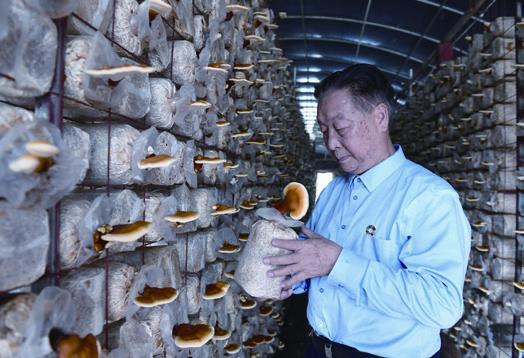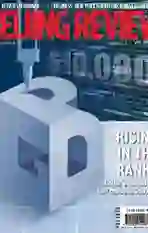Miracle Grass
2020-02-17ByJiJing
By Ji Jing
Mushrooms and grass, seemingly unrelated, have been innovatively combined by a Chinese agro-scientist to create miraculous results in poverty alleviation.
In the 1980s, farmers in Fujian Province in southeast China felled trees and used wood chips and sawdust to grow mushrooms. The mushroom industry helped local farmers increase their income, but Lin Zhanxi, then a technician at the Fungus Research Institute of Sanming City in Fujian, worried about the ecological impact of lumbering.
To reduce the environment damage, Lin tried to replace timber with grass as a substrate for growing fungi. In 1986, he managed to cultivate edible and medicinal fungi using wild grass species such as dicranopteris pedata. For his discovery, Lin won the gold prize in 1992 at the International Exhibition of Inventions of Geneva, the most important invention exhibition in the world.

Lin named the herbal plants for growing edible mushrooms Juncao because he wanted people in the world to know his mushroom- growing technology as a Chinese invention. Over the years, Lin has cultivated over 40 different kinds of wild grass for growing more than 50 varieties of mushrooms.
The technology has not only helped farmers in Fujian increase their income, but also spread to over 500 counties across China and more than 100 countries in the world.
On December 1, 2019, Faustin-Archange Touadera, President of the Central African Republic (CAR), awarded the Commander medal to Lin and other experts for their contribution to the nations agricultural development.
Fighting poverty
Lins team first went to Ningxia Hui Autonomous Region in northwest China, which Fujian had paired with in a poverty-alleviation program, in 1999. They built edible mushroom demonstration stations in several counties in the region and trained local farmers in the new technique. About 17,000 households began to grow Juncao, with the annual income for each household increasing by 8,000 yuan ($1,164) on average.
In 1994, Juncao technology was selected as a priority cooperation project for China and other developing countries by offi cials from the United Nations Development Programme, who visited Fujian Agriculture and Forestry University, where Lin works.
In 1996, Lins team took the technology to the Eastern Highlands Province of Papua New Guinea (PNG). His team dug ditches in the fi elds and covered them with plastic to create a suitable temperature and humidity for growing mushrooms. The method was easy to learn.
“We managed to cultivate a variety of edible mushrooms fairly quickly using local wild grass, and when we announced the news, over 5,000 local people held a meeting to celebrate the success where the Chinese national flag was raised and the national anthem was played,”Lin recalled. Since there were several experts surnamed Lin in the team, local people called the Juncao technology Lincao to show their gratitude.
In 2000, at the invitation of Xi Jinping, who was then governor of Fujian, the governor of the Eastern Highlands Province of the PNG visited Fujian and the two sides signed an agreement for Fujian to help the PNG province with mushroom growing and upland rice planting. Lin was designated as the head of the expert team.
Ahead of his state visit to PNG in November 2018, Xi, as president of China, had a signed article, Set Sail on a New Voyage for Relations Between China and Pacific Island Countries, published in two PNG newspapers.
“Eighteen years ago when I was governor of Chinas Fujian Province, I personally pushed for a demonstration project to help the Eastern Highlands Province of Papua New Guinea with mushroom and upland rice planting. I am glad to learn that this project, still in operation to this day, has produced good economic and social benefi ts for the local community and become a success story in the growth of China-Papua New Guinea relations,” the article said.
After PNG, the technology spread to other South Pacific countries such as Fiji, and to African countries including Rwanda and CAR. Since the Beijing Summit of the Forum on China-Africa Cooperation in September 2018, China-CAR cooperation has entered the fast track, and in March 2019, a Juncao technology project was initiated in the country.

As one of the poorest nations in the world, CAR often suffers from famine, so Juncao technology brought new hope for improving local food security. Lin led a team to visit CARs capital Bangui to push for the implementation of the project. During the visit, the team hosted a Juncao technology symposium to showcase the varieties of mushrooms that had been cultivated in Bangui.
Touadera, who attended the event, enjoyed the dishes and said he hoped more people from CAR would be able to reap the fruits of the two countries cooperation in Juncao technology.
The president also said the technology has opened up opportunities for the countrys agricultural development and could contribute to poverty alleviation, create jobs, improve food security and increase peoples income.
Under the project, Chinese experts taught the method of mushroom growing to local researchers and farmers, who successfully grew several varieties including oyster mushrooms and bamboo fungi.
Protecting the environment
In addition to growing mushrooms, Juncao technology has been used to control water and soil erosion since 2011, when Lins team carried out a demonstration project in Rwanda.
At the source of the Nile, the African country has serious water and soil erosion resulting from a sharp decline in forests by years of war. The team discovered that fields using Juncao have much less water and soil loss than those grown with corn.
Lin has also experimented with Juncao to prevent and treat desertifi cation in the Ulan Buh Desert in Inner Mongolia Autonomous Region in north China. Their fl ourishing roots fi xed the mobile dunes within months.
Lins dream is to make the Yellow River clear again by growing grass along its banks. The proj- ect will not only build a barrier safeguarding the rivers ecological safety, but also set an example for other countries in the world.
Juncao has also been extracted for producing biofuel and new materials in recent years.
As the inventor of Juncao technology, Lin has not sought business profi t from his innovation, even though he has been ridiculed for lacking business sense. However, he thinks it more valuable to help people out of poverty than to seek personal gain.
As the Belt and Road Initiative unfolds, more and more countries participating in the initiative are willing to import the technology for their development. Lin remains willing and able to replicate the Juncao model for poverty alleviation in more countries.
